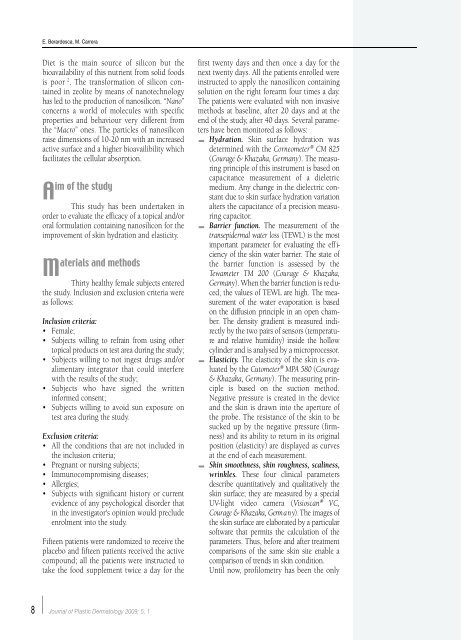Vol. 5, n. 1, January-March 2009 1th International ... - Salute per tutti
Vol. 5, n. 1, January-March 2009 1th International ... - Salute per tutti
Vol. 5, n. 1, January-March 2009 1th International ... - Salute per tutti
Create successful ePaper yourself
Turn your PDF publications into a flip-book with our unique Google optimized e-Paper software.
8<br />
E. Berardesca, M. Carrera<br />
Diet is the main source of silicon but the<br />
bioavailability of this nutrient from solid foods<br />
is poor 2 . The transformation of silicon contained<br />
in zeolite by means of nanotechnology<br />
has led to the production of nanosilicon. “Nano”<br />
concerns a world of molecules with specific<br />
pro<strong>per</strong>ties and behaviour very different from<br />
the “Macro” ones. The particles of nanosilicon<br />
raise dimensions of 10-20 nm with an increased<br />
active surface and a higher bioavailibility which<br />
facilitates the cellular absorption.<br />
im of the study<br />
A<br />
This study has been undertaken in<br />
order to evaluate the efficacy of a topical and/or<br />
oral formulation containing nanosilicon for the<br />
improvement of skin hydration and elasticity.<br />
aterials and methods<br />
M<br />
Thirty healthy female subjects entered<br />
the study. Inclusion and exclusion criteria were<br />
as follows:<br />
Inclusion criteria:<br />
• Female;<br />
• Subjects willing to refrain from using other<br />
topical products on test area during the study;<br />
• Subjects willing to not ingest drugs and/or<br />
alimentary integrator that could interfere<br />
with the results of the study;<br />
• Subjects who have signed the written<br />
informed consent;<br />
• Subjects willing to avoid sun exposure on<br />
test area during the study.<br />
Exclusion criteria:<br />
• All the conditions that are not included in<br />
the inclusion criteria;<br />
• Pregnant or nursing subjects;<br />
• Immunocompromising diseases;<br />
• Allergies;<br />
• Subjects with significant history or current<br />
evidence of any psychological disorder that<br />
in the investigator's opinion would preclude<br />
enrolment into the study.<br />
Fifteen patients were randomized to receive the<br />
placebo and fifteen patients received the active<br />
compound; all the patients were instructed to<br />
take the food supplement twice a day for the<br />
Journal of Plastic Dermatology <strong>2009</strong>; 5, 1<br />
first twenty days and then once a day for the<br />
next twenty days. All the patients enrolled were<br />
instructed to apply the nanosilicon containing<br />
solution on the right forearm four times a day.<br />
The patients were evaluated with non invasive<br />
methods at baseline, after 20 days and at the<br />
end of the study, after 40 days. Several parameters<br />
have been monitored as follows:<br />
H y d r a t i o n . Skin surface hydration was<br />
determined with the Corneometer ! CM 825<br />
(Courage & Khazaka, Germany). The measuring<br />
principle of this instrument is based on<br />
capacitance measurement of a dieletric<br />
medium. Any change in the dielectric constant<br />
due to skin surface hydration variation<br />
alters the capacitance of a precision measuring<br />
capacitor.<br />
B a rrier function. The measurement of the<br />
t r a n s e p i d e rmal water loss (TEWL) is the most<br />
important parameter for evaluating the eff iciency<br />
of the skin water barrier. The state of<br />
the barrier function is assessed by the<br />
Tewameter TM 200 (Courage & Khazaka,<br />
G e rm a n y). When the barrier function is re d uced,<br />
the values of TEWL are high. The meas<br />
u rement of the water evaporation is based<br />
on the diffusion principle in an open chamb<br />
e r. The density gradient is measured indirectly<br />
by the two pairs of sensors (tem<strong>per</strong>ature<br />
and relative humidity) inside the hollow<br />
cylinder and is analysed by a micro p ro c e s s o r.<br />
Elasticity. The elasticity of the skin is evaluated<br />
by the Cutometer ! MPA 580 (Courage<br />
& Khazaka, Germany). The measuring principle<br />
is based on the suction method.<br />
Negative pressure is created in the device<br />
and the skin is drawn into the a<strong>per</strong>ture of<br />
the probe. The resistance of the skin to be<br />
sucked up by the negative pressure (firmness)<br />
and its ability to return in its original<br />
position (elasticity) are displayed as curves<br />
at the end of each measurement.<br />
Skin smoothness, skin roughness, scaliness,<br />
w r i n k l e s . These four clinical parameters<br />
describe quantitatively and qualitatively the<br />
skin surface; they are measured by a special<br />
U V-light video camera (Vi s i o s c a n ! V C ,<br />
Courage & Khazaka, Germ a n y). The images of<br />
the skin surface are elaborated by a particular<br />
s o f t w a re that <strong>per</strong>mits the calculation of the<br />
parameters. Thus, before and after tre a t m e n t<br />
comparisons of the same skin site enable a<br />
comparison of trends in skin condition.<br />
Until now, profilometry has been the only

















